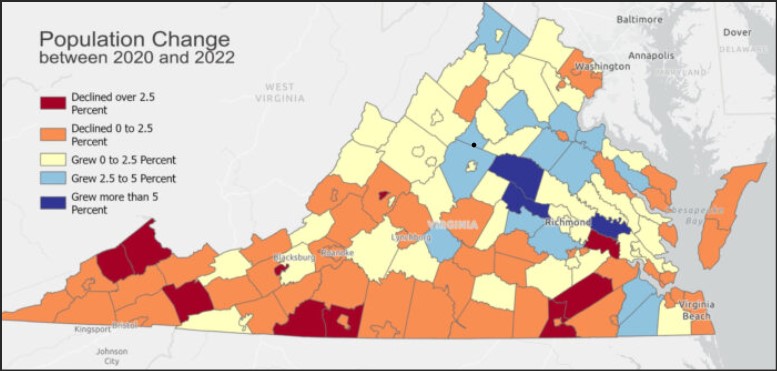by James A. Bacon
The COVID-19 pandemic changed the dynamics of population growth in Virginia. For decades Northern Virginia, with Fairfax County at its core, led population growth in Virginia. And in the 2010s, Virginia’s central cities experienced a population renaissance. But the combination of COVID-19 and sky-high real estate prices have pushed growth out to counties on the metropolitan fringe, mainly around Richmond, but also around Fredericksburg, Charlottesville and Winchester, according to University of Virginia demographer Hamilton Lombard.
The fastest growing localities in Virginia between 2020 and 2022 were New Kent, Goochland, and Louisa counties, expanding by 7.5%, 5.6% and 5.4% respectively. Virginia’s most populous jurisdiction, Fairfax County, lost 26,000 residents. Virginia Beach lost 7,700.
Percentagewise, counties in Southside and Southwest Virginia were among the biggest losers. Some counties in those economically depressed regions also continued to experience out-migration, but several managed to buck the trend. A bigger factor was the fact that the populations of these localities are so much older that deaths outnumbered births.
Writing in the UVa demographic research group blog StatChat, Lombard said it was “unclear” whether the COVID-era trends would continue or reverse themselves. Either way, the population movements between 2020 and 2022 were striking, as the following map shows.
The past two years have seen a surge of in-migration in the dark blue blob around Richmond, Fredericksburg, and Charlottesville.
However, the rapid growth in the Richmond-Fredericksburg-Charlottesville triangle must be viewed in the context that Virginia is experiencing the slowest overall population increase in decades.
Here are what Lombard sees as the forces driving the new migration trends:
Many residents who left Northern Virginia moved to the fast-growing metro areas in the South, such as Raleigh or Charlotte, but a large number of movers also stayed in Virginia moving to nearby counties and cities. Migration from Northern Virginia into the Richmond Metro area has risen by nearly 40 percent since the mid-2010s. Richmond has been so attractive to Northern Virginians and residents of other large metro areas that in 2022 Zillow ranked it the second most popular metro area in the country for prospective home buyers, while Bon Air in Chesterfield County was ranked the third most popular zip code by Zillow. As the economy strengthened in the late 2010s, migration into many of Virginia’s small metro areas and rural counties increased, driven in part by people leaving large East Coast urban areas.
… There are also some significant differences between today and the 2000s, notably how much more expensive housing is in many of the country’s large urban areas, particularly Northern Virginia. Since 2010, the median home price in Prince William, where many of Louisa’s new residents have moved from, has risen from $34,000 more than in Louisa to nearly $200,000 more last year, in other Northern Virginia counties the median home price is close to $400,000 more. Another difference is how ubiquitous remote work has become, allowing many workers to live further from their employer and helping spur growth in Virginia’s rural and exurban counties. If current patterns continue, Virginia may soon experience trends similar to a time prior to the Great Recession with exurban counties struggling to keep up with population growth and some cities struggling to cope with a declining population and tax base.




